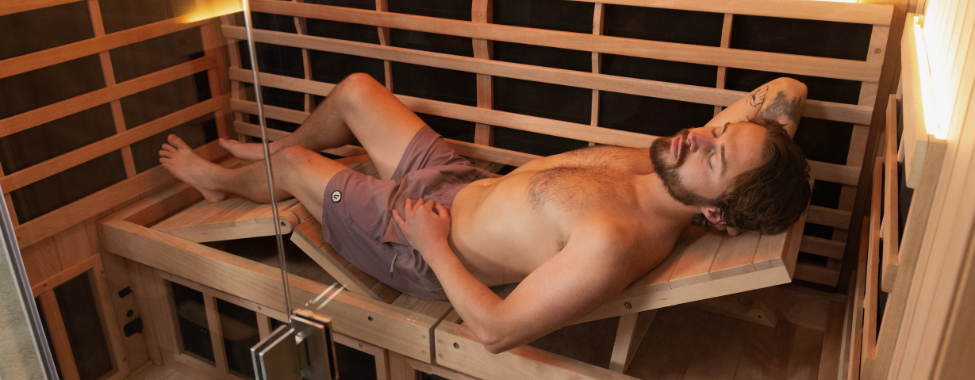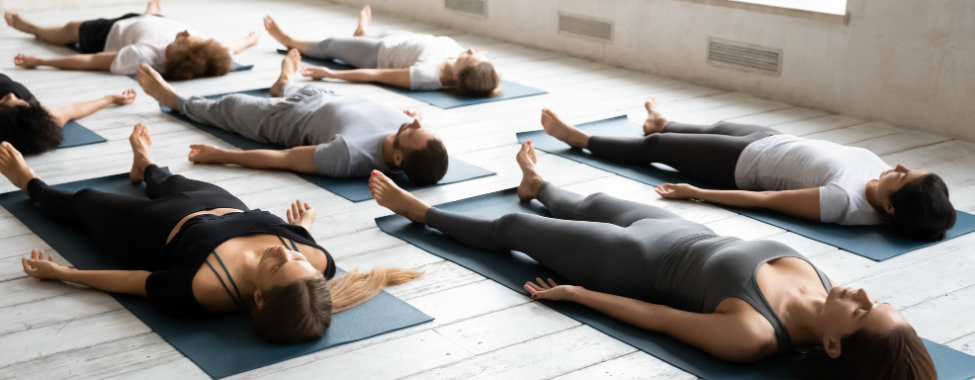Past studies indicate that health and wellness are two topics that many men disregard. According to a 2023 men’s health survey conducted by the Cleveland Clinic, 44% of respondents said they don’t visit the doctor for an annual physical, while 49% admitted that they don’t have healthy diets. In addition, 83% of the men questioned by the Cleveland Clinic admitted experiencing stress during the past six months.
Does this sound familiar to you? If you are looking for natural and sustainable ways to improve your health as a man, there are plenty of ways to start building a wellness routine to help you lead a healthier lifestyle. One of those ways? Infrared sauna use. Read on to learn more about the benefits of infrared saunas for men, along with more tips on how to naturally improve your health.

Men’s Health Benefits from Infrared Saunas
Boost Muscle Recovery and Performance
Men who regularly engage in strength training, high-impact sports, or endurance exercise can benefit from faster muscle recovery. Soreness, tightness, and joint stiffness not only reduce performance but can also lead to injury if ignored.
How infrared saunas help: Infrared heat penetrates deep into soft tissue, increasing circulation and promoting cellular repair. A 2015 study found that infrared sauna bathing post-exercise showed positive results for the neuromuscular system to recover from maximal endurance performance. Improved blood flow brings oxygen and nutrients to fatigued muscles, helping flush out lactic acid and reduce inflammation. Regular sessions may also support joint health, increase mobility, and reduce the strain from intense physical activity.
Men’s health routine tip: Use your infrared sauna within an hour of workouts to maximize circulation. Consider pairing with red light therapy or PEMF (Pulsed Electromagnetic Field) therapy to further enhance cellular repair and tissue healing.
Ease Joint Pain and Support Mobility
Joint pain is one of the most common physical complaints among aging men, athletes, and those with physically demanding jobs.
How infrared saunas help: Infrared therapy increases circulation, reduces inflammation, and may help relieve pain without the side effects of medication. A 2009 study showed that patients with rheumatoid arthritis experienced less stiffness and pain after four weeks of infrared sauna therapy. This therapy can be especially helpful for men with old sports injuries, arthritis, or those simply feeling the effects of aging. Unlike cold therapy, which numbs the area, infrared heat helps repair it from the inside out.
Men’s health routine tip: Combine sauna use with stretching or foam rolling. You can also explore vibrational resonance therapy to gently stimulate the body’s natural healing frequencies and enhance mobility further.
Helps Reduce Stress
Modern men face stressors from work, relationships, and environmental pressures. Chronic stress can lead to mood disorders, fatigue, poor focus, and even hormone disruption.
How infrared saunas help: Infrared saunas for men can help reduce stress, which often leads to a better night’s sleep. The treatment has been found to lower cortisol, your body’s stress hormone. Lowering cortisol levels has many positive effects, including decreasing blood pressure, reducing inflammation, and regulating your body’s metabolism. Lower cortisol levels also help your body better regulate its sleep patterns, allowing you to rest uninterrupted.
Men’s health routine tip: For maximum benefits, schedule your sauna sessions at the end of your workday. Add calming music or breathwork, and consider combining with chromotherapy for an extra calming effect.
Improve Sleep Quality and Circadian Rhythm
Poor sleep is a growing concern for men of all ages, affecting everything from testosterone levels to mental focus and immunity.
How infrared saunas help: Saunas gently elevate your core temperature, and the subsequent cooldown mimics the natural decline in body temperature that signals your brain to release melatonin. This helps recalibrate circadian rhythm and prepare your body for rest. In a global survey of sauna users, 83.5% reported better sleep after regular infrared sauna use. Additional relaxation from endorphin release may also reduce nighttime anxiety or racing thoughts.
Men’s health routine tip: Try a 25-minute sauna session 1–2 hours before bedtime. Avoid screens afterward, and combine your sauna time with relaxing essential oils like chamomile or lavender. Magnesium or a sleep-supporting supplement may also help round out your routine.
Can Aid in Weight Loss
Men dealing with stubborn belly fat or slow metabolism may benefit from the passive calorie burn and metabolic support infrared saunas provide.
How an infrared sauna helps: Believe it or not, you may be able to lose weight by spending just 30 minutes in an infrared sauna. Studies have found that a short session in one may increase your metabolic rate. For instance, a study by Binghamton University in New York found that participants who used an infrared sauna for three 30-minute weekly sessions lost 4% of body fat in four months. The high heat in an infrared sauna also helps you shed water weight through sweat.
Men’s health routine tip: Don’t rely on saunas alone. Combine with strength training, a high-protein diet, and hydration. Infrared heat can also enhance detox pathways, helping your body shed metabolic waste and toxins that might otherwise burden fat loss efforts.

Can Reduce the Risk of Heart Disease
Heart disease remains the leading cause of death among men, making cardiovascular wellness a top priority. According to the U.S. Centers for Disease Control and Prevention (CDC), men are twice as likely to die of heart disease than women.
How an infrared sauna helps: Because an infrared sauna helps increase blood flow, improve circulation, and lower cholesterol and blood pressure, it’s a good tool to help improve men’s cardiovascular health, potentially reducing the risk of heart disease. One study found that frequent sauna use was associated with a reduction in fatal heart disease compared to once-weekly use.
Men’s health routine tip: Aim for 4–7 infrared sauna sessions per week at 120–140°F for 20–30 minutes. To deepen the relaxation effect, turn on color light therapy and try adding calming aromatherapy like lavender.
Can Help Strengthen the Brain
Cognitive decline is a growing concern for aging men, especially as the rates of dementia and Alzheimer’s disease continue to rise. Maintaining brain health isn’t just about memory, it also affects mood, focus, and quality of life.
How an infrared sauna helps: Studies have found that the use of infrared saunas can reduce the risk of dementia and Alzheimer’s disease in men. A 2017 Finnish study looked at the sauna use of 2,315 healthy men between the ages of 42 and 60 and found that those who used an infrared sauna two to three times per week had a 20% to 21% lower risk of dementia or Alzheimer’s. Those men who used the infrared sauna more often – between four and seven times a week – had an even lower risk, averaging around 65% to 66%.
Men’s health routine tip: To promote mental sharpness and memory, incorporate sauna sessions into your weekly routine, ideally 4+ times per week. For a sensory boost, consider pairing with peppermint or rosemary aromatherapy, both known to support focus and alertness.
Enhance Skin Health and Detoxification
Between shaving irritation, clogged pores, and aging, men’s skin can take a beating. Add environmental toxins and inflammatory foods, and detox support becomes even more essential.
How infrared saunas help: Unlike traditional saunas that heat the air, infrared saunas heat the body directly, inducing a deep, cleansing sweat that helps flush toxins. This sweat comes from deeper layers of tissue, resulting in more efficient detoxification. At the same time, increased circulation delivers oxygen and nutrients to the skin’s surface, promoting collagen production and a clearer complexion.
Men’s health routine tip: Exfoliate gently after sessions and hydrate with a mineral-rich moisturizer. For even better results, stack infrared with red light therapy to stimulate collagen and improve tone, or pair your session with halotherapy to help soothe skin conditions.
Ease Joint Pain and Support Mobility
Joint pain is one of the most common physical complaints among aging men, athletes, and those with physically demanding jobs.
How infrared saunas help: Infrared therapy increases circulation, reduces inflammation, and may help relieve pain without the side effects of medication. A 2009 study showed that patients with rheumatoid arthritis experienced less stiffness and pain after four weeks of infrared sauna therapy.
This therapy can be especially helpful for men with old sports injuries, arthritis, or those simply feeling the effects of aging. Unlike cold therapy, which numbs the area, infrared heat helps repair it from the inside out.
Mobility routine tip: Combine sauna use with stretching or foam rolling. You can also explore vibrational resonance therapy to gently stimulate the body’s natural healing frequencies and enhance mobility further.

Additional Ways to Naturally Improve Men’s Health
While infrared saunas are an effective tool for improving men’s health, incorporating other natural methods can further enhance overall well-being. A holistic approach to health can address various aspects of physical, mental, and emotional well-being, making a significant difference in quality of life. Below are several effective strategies:
Regular Exercise
Regular exercise helps maintain a healthy weight, improves cardiovascular health, strengthens muscles and bones, and boosts mental health. Men should aim for at least 150 minutes of moderate aerobic activity or 75 minutes of vigorous activity each week, as recommended by the American Heart Association.
Healthy Diet
A balanced diet is crucial for maintaining good health. For men, this means incorporating a variety of foods rich in essential nutrients such as proteins, healthy fats, vitamins, and minerals. Foods like lean meats, fish, eggs, legumes, fruits, vegetables, nuts, and whole grains should be staples in the diet.
Adequate Sleep
Quality sleep is often overlooked but is vital for overall health. Adults typically need between 7 to 9 hours of sleep per night. Poor sleep can lead to numerous health issues, including cognitive decline, increased stress levels, weight gain, and a weakened immune system.
Stress Management
Stress can take a significant toll on men’s health, leading to conditions such as hypertension, heart disease, and mental health disorders like anxiety and depression. Finding effective ways to manage stress is crucial. Techniques such as mindfulness meditation, yoga, and deep-breathing exercises can help reduce stress levels.

Red Light Therapy
Red light therapy (RLT) benefits men’s health by helping increase testosterone levels, optimizing sleep, and enhancing muscle recovery. It can also help promote hair growth, improve cognitive function, mood, and heart function, and support joint health. It offers a non-invasive, natural way to boost overall well-being and vitality.
RLT devices come in many forms to fit your needs and lifestyle, including the Clearlight PERSONAL Red Light Therapy Tower for targeted support anywhere you need it, the Clearlight CORE Tower that can be installed in your infrared sauna to enhance the benefits of each, and the Clearlight FULL BODY Tower for revitalizing RLT for your whole body.
Limit Alcohol and Quit Smoking
Excessive alcohol consumption and smoking are significant risk factors for many health issues, including liver disease, cardiovascular diseases, and various forms of cancer. Limiting alcohol intake to moderate levels and quitting smoking can substantially reduce these risks and contribute to better overall health.
Hydration
Adequate hydration is essential for maintaining all bodily functions. Drinking enough water can improve digestion, aid in nutrient absorption, and maintain healthy skin. Men should aim for at least eight 8-ounce glasses of water a day, more if they are physically active or live in a hotter climate.
Regular Medical Check-ups
Preventative healthcare is crucial. Regular visits to a healthcare provider for screenings and check-ups can help detect potential health issues early on. Men should discuss their individual health needs with their doctors, including screenings for cholesterol levels, blood pressure, diabetes, and prostate health.

FAQ: Men and Infrared Saunas
Is there an age limit for using infrared saunas?
There’s no strict age limit, but infrared saunas are typically recommended for adults and older teens. Teenagers may benefit with adult supervision, especially when sessions are brief (10–15 minutes) and set at lower temperatures. For seniors, it’s best to consult with a healthcare provider before use, particularly if there are mobility, heart, or blood pressure concerns.
Are there any health risks or side effects of using an infrared sauna?
Infrared saunas are generally well-tolerated, but hydration is key. Potential side effects may include dizziness, overheating, or dehydration, especially in longer or hotter sessions. People with cardiovascular issues, low blood pressure, or certain medications should check with a healthcare provider before starting regular use. It’s also wise to avoid sauna use when ill or immediately after alcohol consumption.
How often should men use infrared saunas?
For most men, starting with 3–5 sessions per week lasting 20–40 minutes at 120–150°F is a solid routine. More frequent sessions (up to daily use) can be safe if your body responds well. Always listen to your body and stay hydrated before, during, and after each session.
Do saunas affect testosterone?
While infrared saunas won’t directly boost testosterone levels, they may support healthy hormone function indirectly. By improving sleep quality, reducing stress, and enhancing cardiovascular health, sauna use can help create internal conditions that promote balanced testosterone production.
Can men use saunas when trying to conceive?
Heat exposure from any source can temporarily lower sperm count or motility, particularly with frequent or prolonged sauna sessions. If you’re actively trying to conceive, consider using saunas less frequently, shortening session time, or taking a break during your fertility window. For individualized advice, consult your healthcare provider.
Boosting Men’s Overall Health and Wellness
Incorporating these natural strategies into daily life, along with the use of infrared saunas, can significantly enhance men’s health and wellness. From reducing toxins, relieving inflammation, and lowering blood pressure to minimizing pain, alleviating stress, and losing weight, the benefits of saunas for men can boost overall health and wellness across several dimensions.
Every day is an excellent opportunity to adopt these practices and commit to a healthier lifestyle. By making gradual, sustainable changes, men can improve their overall well-being and enjoy a higher quality of life.
 Canada
Canada Australia
Australia New Zealand
New Zealand Germany
Germany UK
UK EU
EU Ireland
Ireland Malaysia
Malaysia China
China Japan
Japan


































